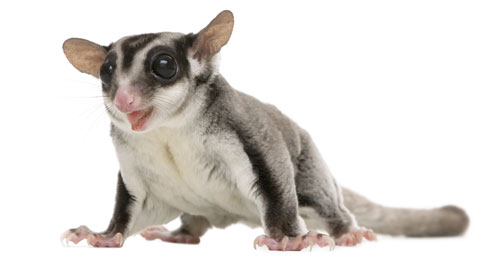Sugar gliders as Pets
Are you wondering if sugar gliders as pets are a good choice for
you?
There are many reasons people want to own a pocket-perched sugar
glider. Some people like the idea of owning an exotic pet. Others
simply fall in love with the way they look. With those large eyes and
round face, sugar gliders do have a cute, adorable, baby-animal appeal.
Sugar gliders as pets are excellent because they tend to form a very close bond with their keeper. This tendency to form close attachments make sugar gliders the perfect pet for older children and adults who are able to give them plenty of time and attention. Sugar gliders will actually glide from a high perch across the room to nestle into their owner's pocket.

These Adorable Little Pets Glide Through the Air
In their natural Australian habitat, sugar gliders tend to be social and typically form groups, or a nest of up to eight adults along with any young. Dominant male sugar gliders will mark each member of his group with scent glands. Any sugar gliders without the appropriate scent markings are violently driven out of the nest which may account for any rare, aggressive behavior while in captivity.
While sugar gliders may sometimes snap or even bite, this is not typical behavior. Since sugar gliders tend to bond with their keepers, it may be best to get them as young as possible - right after they have been weaned. Younger sugar gliders tend to bond more readily to their keepers.
Bringing Your New Sugar Glider Home
You may need to get used to certain types of behavior that are normal for sugar gliders. These little animals are nocturnal which means they are active at night and sleep during the day. Since you have formed a close bond with your little friend, you will likely need to provide about an hour or more of activity outside the cage every night.
Sometimes, a sugar glider may make certain noises in the middle of the night. This may mean that they are calling out because they are hungry or may just need some companionship. A few drops of yogurt or a nice, juicy meal worm may help to quiet their noisemaking.
Providing a Good Home for Your Sugar Glider
A large cage that allows your sugar glider to climb and jump will make the best type of home. A good size for this cage would be at least 20 x 20 inches wide and at least 36 inches high. The wires in this cage should be coated metal and no more than one-half inch apart.
A separate tray placed beneath the wire cage floor and just beyond the reach of your sugar glider works best. Fill this tray with organic pellets, aspen shavings or recycled paper products to catch any droppings. Cedar shavings should not be used in this tray.
Make time to clean the enclosure and tray at least once every day to keep odors under control. A simple light bulb may provide adequate heat.
Caring for Sugar Glider Lizards
Sugar gliders as pets need proper food and adequate water
Sugar Gliders need the right food and access to water in order to live a long, healthy life. The ideal diet includes a variety of fresh foods like chopped fruits, veggies, eggs, cooked meat, meal worms, yogurt and tofu. For a special treat, keep some sunflower seeds on-hand.
A water bottle attached to the outside of the cage should provide enough fresh drinking water. Take good care of your sugar glider and it may live as long as 15 years.
Toys, Toys and More Toys
Sugar gliders that are active tend to live longer, happier lives. Providing the right toys in large numbers makes it easier for your pet to be active and playful. Sugar gliders love toys, especially those that require interaction.
Various tubes, hammocks, small balls that have a bell inside and those that have rotating parts make especially good toys. Engaging in play will help to keep them healthy and prevent boredom.
The Pre-Purchase Sugar Glider Checklist
Be certain to have everything necessary to provide a good home for your sugar glider. Here is a checklist of what is needed before you bring your sugar glider home:
- large cage, at least 20 x 20 inches and at least 36-inches high
- climbing branches, exercise wheel and resting platform should be inside the cage
- water bottle and food dish
- nest box and an adequate amount of litter
- fleece-lined sleeping pouch
- several bird toys or other suitable interactive toys
- a light source for heat
- a variety of fresh foods
Find out what it takes to provide proper care and feeding for a pocket-perched sugar glider. You should always do some research before buying any pet. Make sure you can commit to everything needed to provide your sugar glider a proper home and care for a long time.
Sugar Glider Habitats
In the U.S., most states and cities allow people to keep sugar gliders as pets, however, some states like California, Alaska, Hawaii, Massachusetts and Pennsylvania do place certain restrictions on owners.
Once you have done research and found a place in your heart for one of these adorable gliding marsupials, take one home and care for it according to these guidelines to have a healthy and happy sugar glider.
Comments
Have your say about what you just read! Leave me a comment in the box below.